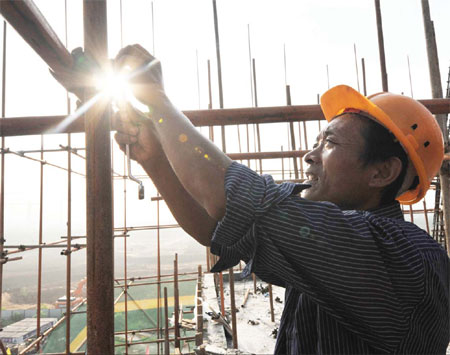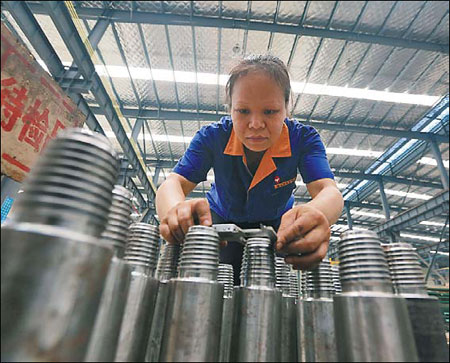Economic slowdown 'due to rebalancing'
Updated: 2013-07-19 09:17
By Chen Jia, He Yini, He Wei and Fu Jing (China Daily)
|
|||||||||||
|
First-half figures show a slowdown in China's growth that analysts say demonstrates the new leadership's determination to rebalance the economy. Li Zongxian / for China Daily |
|
Data shows investment in the manufacturing sector hit 7.8 trillion yuan in the first half. Provided to China Daily |

Nation 'still capable of keeping steady growth momentum in second half'
China's economy grew by 7.6 percent year-on-year in the first half, a marked slowdown in comparison with near double-digit growth recorded two years ago.
A government spokesman says that reducing the growth rate is aimed at making room for rebalancing the economy.
The nation is capable of keeping growth momentum steady for the rest of the year, even though the economic environment is expected to remain grim and complicated, he adds.
The government's yearly GDP growth target for 2013, set earlier this year, is 7.5 percent.
Sheng Laiyun, spokesman for the National Bureau of Statistics, says that despite the slowdown, China's growth is still higher than that in other major economies.
The nation saw economic growth fall to 7.5 percent in the second quarter, from 7.7 percent in the first and 7.9 percent in the fourth quarter of 2012.
Investment was the biggest growth driver in the first half of the year, contributing 4.1 percentage points to the 7.6 percent rate, while consumption contributed 3.4 percentage points and net exports 0.1 percentage point, the bureau says.
Industrial output in the first six months grew by 9.3 percent from a year earlier, compared with a 10.5 percent increase in the first half of 2012.
Annual growth of fixed-asset investment in the first half lost some steam, rising 20.1 percent year-on-year, down from 20.9 percent.
Meanwhile, consumer goods retail sales rose by 12.7 percent, 1.7 percentage points lower than in the first two quarters of 2012.
The slowdown was caused by the weak global economic recovery and measures taken by the new leadership, Sheng says.
Jonathan Holslag, a research fellow at the Brussels Institute of Contemporary China Studies, says the figures send a very strong signal that the central government is making efforts to rebalance the economy.
"The growth rate is still optimistic when considering the scale of China's economy and is still contributing a lot to the global economy," says Holslag.
But he says this year will be very challenging for the country to restructure the economy against a backdrop of global hardship. Holslag stressed that the risks the government faces come from the banking sector and the stock market.
"An economic slowdown is like a forest fire (that gets rid of the underbrush) in a forest. It's terrible at first, but then it cleans out the excesses of the current system, and everyone will be better off when the economy starts over from a sound base," Jim Rogers, an international investment guru, says.
"It's happening in China at the moment as the government stays tight to cool things down. But I think it's a good thing."
The government says in a guideline issued on July 5 that it would continue belt-tightening and scale back the supply of funds in the market to a reasonable level to contain a debt-fueled economic boom.
The guideline came after a liquidity crunch, which triggered a dive in the stock market and pushed interbank rates to record highs, had eased. But economic concerns linger.
"The Chinese government does have a plan to stay tight to calm things down. Some people are going to suffer, and that's what's happening. But that will be good for China in the end," says Rogers.
"Even if some sectors of the Chinese economy have a hard landing and some people go bankrupt, people (doing business) in other sectors, such as agriculture, culture, pollution, etc, will not be affected at all, because these fields will enjoy great prosperity in the years to come."
These fields, Rogers says, will be new sweet spots for investment in China.
He says all countries that rise have periodic setbacks along the way, but that's the way the world works.
"China is going to be the most important country in the 21st century, and eventually the largest economy in the world," he says.
An adjusted growth target of 7 percent may emerge in 2014, setting the country on a temporary turbulent journey toward a more-balanced economy, according to Michael McDonough, senior economist at Bloomberg LP.
But for the next six months, the government may still accelerate investment projects and cut interest rates, among other efforts to defend a 7.5 percent GDP growth target, he says.
It is interesting to note that historically, the government's target has acted more as a floor than a legitimate target. But this year that is very likely to change, McDonough says.
The 4 trillion yuan ($651 billion) stimulus package enacted following the 2008 financial crisis, while bolstering growth, essentially led to a surge in credit expansion and generated extensive industrial overcapacity, which McDonough says was responsible for much of the current slowdown.
The overcapacity is especially obvious in the manufacturing sector, where the Producer Price Index, a main gauge of inflation at the wholesale level, has dropped for 16 consecutive months, indicating tepid domestic demand.
Another case in point is the surging amount of social financing after the 2008 input, where an increasing portion of these loans, which targeted lower-valued projects, may struggle to stay afloat in an environment of slowing growth.
Annual new yuan loan-issuance between 2008 and 2012 was on average more than 140 percent above the 2007 level.
McDonough has noticed a change in the response to the slowdown compared with five years ago.
"While the government still has room to increase investment in certain infrastructure projects that may boost urbanization, a goal the new leadership has highly valued, officials are showing a restrained response and instead, attempting to encourage more private-sector involvement," he says.
He believes that the urbanization-driven infrastructure investment is going to be a value-added, smart use of money to bring people to cities and have a decent return in the long run, where the stimulus program only resulted in industry bubbles.
While these types of investment may accelerate in the second half of the year, the aim will probably be to achieve the government's official target, rather than what investors may perceive as market-friendly 8 percent growth, he adds.
"Allowing slower growth implies China's economy may be in store for some pain before the situation improves. But it also signifies that officials are increasingly willing to act to rebalance the economy, placing it on a sounder footing in the longer term."
While officials have publicly recognized that China's economy needs to lessen its dependence on investment, there has yet to be tangible success on that front.
Investment's share of GDP rocketed to 48.3 percent in 2011, while household consumption shrank to 35.4 percent, compared with 50 percent in 1989.
McDonough says that the rising contribution of investment has meant that slower growth is almost a "necessity" if China is to shift toward consumption and the private sector to drive economic growth.
"If we use the 2011 data (which is the most recent available), just to offset a 1 percent decline in China's gross capital formation, household consumption would need to increase by almost 1.5 percent due to its smaller base level," he says.
But the development model has been proven effective. McDonough refers to the "Great Moderation" period in the 1980s, when former US Federal Reserve chairman Paul Volcker increased the federal funds rate to 20 percent to combat high inflation and slow growth. While this pushed the US economy into a deep recession, it succeeded in lowering inflation, leading to a period of reduced volatility and strong growth.
With China's own transition seemingly underway, near-term risks still exist, though they can probably be manageable. Apart from the outsized credit growth, a slower expansion may be disruptive for China's financial sector.
The recent surge of interbank lending rates has placed pressure on the People's Bank of China to stabilize the sector.
To maintain the 7.5 percent annual growth rate, reforms are likely to accelerate into year-end, McDonough has forecast.
Wang Jun, a senior economist at the China Center for International Economic Exchanges, says that slower growth may push the government to take measures to expand domestic demand, otherwise, difficulties may arise from tight local government financing and increasing unemployment.
He denies that a large stimulus package will be needed, as the new leadership may tolerate a growth rate of no less than 7 percent.
After the statistics bureau released the first-half growth figures, JPMorgan Chase downgraded its forecast for the year's growth to 7.4 percent from 7.6 percent, saying manufacturing investment and overseas demand remain weak.
"A slowdown of GDP growth to 7.5 percent will not trigger a change in policy stance," says Zhu Haibin, chief economist in China with the US bank.
"The new government made it clear that it is willing to tolerate slower growth for better quality of growth. Economic restructuring is the priority task going ahead."
On Monday, Nomura Securities said it will keep its GDP growth forecast for this year at 7.5 percent, but lower it to 6.9 percent for 2014.
"We expect growth to bottom out in the second quarter of 2014 at 6.5 percent," says Zhang Zhiwei, the company's chief economist in China.
"We now expect the central bank to cut the reserve requirement ratio by 50 basis points in each quarter from the third quarter of this year to the second in 2014," Zhang says.
He does not view this cut as a policy easing measure, but as a measure to react to liquidity outflows.
Contact the writers through chenjia1@chinadaily.com.cn,
heyini@chinadaily.com.cn, hewei@chinadaily.com.cn and fujing@chinadaily.com.cn
(China Daily European Weekly 07/19/2013 page20)
Today's Top News
List of approved GM food clarified
ID checks for express deliveries in Guangdong
Govt to expand elderly care
University asks freshmen to sign suicide disclaimer
Tibet gears up for new climbing season
Media asked to promote Sino-Indian ties
Shots fired at Washington Navy Yard
Minimum growth rate set at 7%
Hot Topics
Lunar probe , China growth forecasts, Emission rules get tougher, China seen through 'colored lens', International board,
Editor's Picks

|

|

|

|

|

|







